
As Malinky Robot: Collected Stories and other bits from Image Comics finds it’s way onto shelves, Comic Booked catches up with the Eisner-nominated comic artist, Sonny Liew the man responsible for this charming tale. His other work includes Marvel’s Sense & Sensibility, My Faith in Frankie as well as titles for DC Vertigo, SLG and Disney.
So just what inspired the artist in his tales of Atari and Oliver, two street urchins running amuck in this gloriously defunct dystopian future.
Comic Booked: Your new book, Malinky Robot, is a very warm and charming tale. How personally invested in it were you when creating it?
 Sonny Liew: The first Malinky Robot story was actually first written and drawn as an assignment for David Mazzucchelli’s Graphic Storytelling class at the Rhode Island School of Design. I had no idea where it’d lead to then. I think both the fairly long time span I’ve had with these characters (some 7-8 years now), together with the fact that I’m also writing the stories make them very close to my heart. Every project I’ve worked on with other writers like Mike Carey, Tommy Kovac or Nancy Butler have been special and engaging in their own ways, but Malinky Robot is one where everything in the stories – pacing, structure, rhythm – are my own choices, so it’s a complete immersion in the way the others might not be.
Sonny Liew: The first Malinky Robot story was actually first written and drawn as an assignment for David Mazzucchelli’s Graphic Storytelling class at the Rhode Island School of Design. I had no idea where it’d lead to then. I think both the fairly long time span I’ve had with these characters (some 7-8 years now), together with the fact that I’m also writing the stories make them very close to my heart. Every project I’ve worked on with other writers like Mike Carey, Tommy Kovac or Nancy Butler have been special and engaging in their own ways, but Malinky Robot is one where everything in the stories – pacing, structure, rhythm – are my own choices, so it’s a complete immersion in the way the others might not be.
As a creator-owned title, it’s also, of course, a book where I have to do quite a bit of the promotion, so there’s definitely more investment of time and effort in that sense. Sending out emails, mailers, even getting on twitter for the first time!
CBd You have a background in philosophy, having read at Cambridge University, has this influenced your work at all? And is there a philosophy behind Atari and Oliver, the book’s leads?
SL: I don’t think the philosophy stuff I read in school has really had much direct impact on the comics. Academic philosophy, especially the analytical kind that they taught at Cambridge, gets technical pretty quickly and isn’t quite the same as philosophy in the looser, cracker barrel sense. The impact of my time in the UK was probably more to do with the texture, sounds and sights of things experienced – cycling or running along the rivers, catching sight of animals, exploring unknown places.
With Atari and Oliver, or any of the other characters, I don’t think I created them with philosophies in mind. They emerged gradually from sketches, and I find out about them as I draw them – fictional though they are, I look to them for what happens next, rather than try to impose any preconceptions on them. It’s a discovery in that sense; even what Oliver is supposed to be, is something I only have a vague inkling of, maybe something I’ll find out myself in later stories.
Comic Booked’s Thom Atkinson gets inducted
 CBd: What was the inspiration behind the chosen setting of San’ya (a neighborhood in north-eastern Tokyo) and then setting it in a near dystopian future?
CBd: What was the inspiration behind the chosen setting of San’ya (a neighborhood in north-eastern Tokyo) and then setting it in a near dystopian future?
SL: Well I’d picked up a copy of Edward Fowler’s “San’ya Blues” from the Brown University bookstore’s bargain bin. It was a vivid account of a year he’d spent there as a day labourer, full of incidents and stories of the lives of men (and it was primarily men) who’d ended up there; I thought San’ya would provide a brilliant backdrop for a science fictional world, something to give that world some foundation. One thing that’s always bothered me a little about some science fiction comics is how they end up with these big metaphysical themes that just feel very wooly – setting Malinky Robot in San’ya I think helped keep the stories more real, perhaps.
The dystopian aspect – I guess that’s partly due to my own affection for the crumbling cityscapes of cyberpunk futures, the kind you see in Blade Runner, Transmetropolitan and Geoff Darrow/Frank Miller’s Hard Boiled. The lived-in futures, with rusty robots and hovercars, neon lights and over hanging wires, there’s just something visually and emotionally appealing about them.
CBd: Do you feel you have more freedom when working on your own titles as opposed to being an artist for hire, or are you still overly aware off your readership?
SL: Well, as I mentioned before there’s definitely more freedom in how the stories are told. Am I aware of the readership? I guess you always do worry how others will react. I remember when the first Malinky Robot (“Stinky Fish Blues”) came out, it got quite a scathing review in the Comics Journal, which basically said it was (along with Faryl Dalrymple’s Pop Gun War) a story with nice art but no story. So the question of storytelling has always loomed large; how far I should be trying to conform to traditional narrative structures and how far to depart from them. There’s always the danger of trying to hide bad storytelling by calling it alternative, but it’s also tricky to say if there are objective ways of deciding whether a story is good or bad.
For my part I’ve tried to explore as much as I can what the traditional rules are, and hopefully make at least informed choices in departing from them. I’m sure there’ll still be readers and reviewers who think the stories lack plot or meaning, but reactions so far have generally been very positive, and I hope that means I haven’t been totally self-indulgent in the storytelling choices made.
CBd: You have a unique and beautiful style of drawing that is very original. Do you find you need to adapt or compromise your style when working for other companies?
SL: Adapt yes, compromise maybe not so much. It’s a question of finding the right style for the story. In Sense & Sensibility for example I was hoping to look a little closer to the old classics illustrated comics they had, so inking the pages made sense (if not done very well!) I threw in sections where the characters looked a little more cartoony (or “chibi” as they call it in manga), to help accentuate the comedic tones of those scenes. So I think I try to adapt a little to the needs of the story, what feels right visually.
In any case it’s always fun to try out new styles, and I’ve always enjoyed shifting through different ones even within stories – you see it in the “Bicycle” story in the collection, and its also something I did for the flashback sequences in My Faith in Frankie.
CBd: Are there any established characters out there that you would love to do your own interpretation of?
SL: I had the chance to do a short Spider-Man story with Roger Langridge on writing duties a while back and that was a lot of fun. It was mostly a Ditko homage. I guess everyone wants to do Batman at some point. I’ve also just heard of a character called Magnus the Robot Fighter whom I’ve never seen or read but who sounds totally awesome!
Malinky Robot Preview
CBd: Do you find being based in Singapore liberating or a hindrance in the industry. Or does the digital age mean you can truly work from anywhere?
SL: To a degree yes – you can send files through the Internet, or pages via Fedex, so there’s been a shrinking of the world in that sense. On the other hand living in the states would probably have been better career wise. Whether it’s networking or meeting fans, promoting your books… I only get to go to SDCC once every couple of years; never been to NYCC or APE. There’re opportunities for work, collaborations and friendships that can arise in face-to-face meetings that are harder to come by over email. But getting to be closer to friends and family here in Singapore – I guess that’s a worthwhile tradeoff.
CBd: You have a varied portfolio of work behind you now. Which work do you look back on most fondly and why?
SL: Different projects have different aspects. My Faith in Frankie was my first one with a major publisher so it always has a special place and it was exciting, and nerve-wracking at the same time, having been a big fan of Sandman. I really enjoyed working on Wonderland, with its topsy-turvy world and the chance to explore color palettes and techniques. And there’s Malinky Robot of course. I suppose it’s easier to pick out the bad ones, which would probably be some illustrated books I did a long while back, that I cringe at whenever I see them.
CBd: Looking to the future can you tell us what you are working on next and what the outlook is?
SL: I’m working on an original graphic novel with Gene Yang. It’s the story of an Asian- American Superhero. Also on the backburner for a while now is a Malinky Robot GN, which I’m always hoping to find the time to complete, maybe even a publisher who’d pay me for it! Some paintings, too for exhibitions here in Singapore. We also got the greenlight from Image for a third volume of Liquid City, so that should be kicking off sometime soon too.
For all the latest news and info and Sonny’s work head over to sonnyliew.wordpress.com or http://facebook.com/malinkyrobot
Malinky Robot is out now.


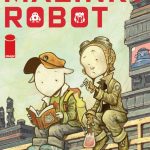

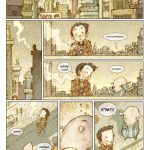
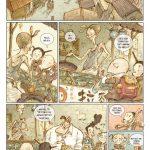
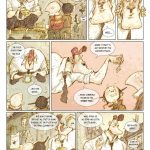
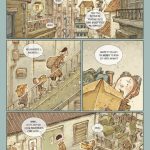
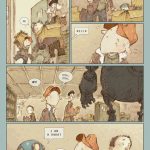
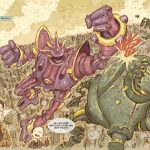
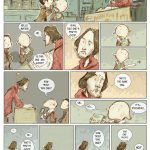












Awesome interview, Thom! This exchange really has some depth to it.
Did he get comicbooked by me or did I get comicbooked by him?
Its an endless moebius strip! :p